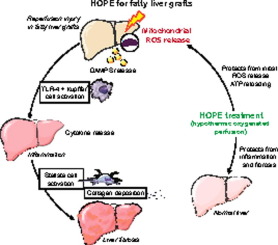当前位置:
X-MOL 学术
›
J. Hepatol.
›
论文详情
Our official English website, www.x-mol.net, welcomes your
feedback! (Note: you will need to create a separate account there.)
Hypothermic oxygenated perfusion (HOPE) for fatty liver grafts in rats and humans
Journal of Hepatology ( IF 26.8 ) Pub Date : 2018-01-01 , DOI: 10.1016/j.jhep.2017.08.028 Philipp Kron 1 , Andrea Schlegel 1 , Leandro Mancina 1 , Pierre-Alain Clavien 1 , Philipp Dutkowski 1
Journal of Hepatology ( IF 26.8 ) Pub Date : 2018-01-01 , DOI: 10.1016/j.jhep.2017.08.028 Philipp Kron 1 , Andrea Schlegel 1 , Leandro Mancina 1 , Pierre-Alain Clavien 1 , Philipp Dutkowski 1
Affiliation

|
BACKGROUND & AIMS
Pretreatment of marginal organs by perfusion is a promising opportunity to make more organs available for transplantation. Protection of human donation after cardiac death (DCD) livers by a novel machine perfusion technique, hypothermic oxygenated perfusion (HOPE), was recently established. Herein, we tested whether HOPE is also useful for fatty liver grafts, using a rodent transplant model. METHODS
Rats were fed over three weeks with a special methionine-choline-deficient diet (MCDD) to induce severe hepatic macrosteatosis (≥60%). Afterwards, livers were transplanted with either minimal or 12h cold storage. Additional liver grafts were treated after 12h cold storage with 1h HOPE before transplantation. Graft injury after orthotopic liver transplantation (OLT) was assessed in terms of oxidative stress, damage-associated molecular patterns release, toll-like receptor-4 activation, cytokine release, endothelial activation, and the development of necrosis and fibrosis. RESULTS
Implantation of cold stored macrosteatotic liver grafts induced massive reperfusion injury after OLT, compared to controls (non-fatty livers). HOPE treatment after cold storage failed to change the degree of steatosis itself, but markedly decreased reperfusion injury after OLT, as detected by less oxidative stress, less nuclear injury, less Kupffer- and endothelial cell activation, as well as less fibrosis within one week after OLT. Protective effects were lost in the absence of oxygen in the HOPE perfusate. CONCLUSION
HOPE after cold storage of fatty livers prevents significant reperfusion injury and improves graft function, comparable to the effects of HOPE in DCD livers and DCD kidneys. HOPE treatment is easy and may become a universal concept to further expand the donor pool. LAY SUMMARY
An increasing number of donor livers contain fat. It is important to harness marginal livers, which may contain fat, as the stock of donor livers is limited. Hypothermic oxygenated perfusion (HOPE) prevents reperfusion injury and improves liver graft function. HOPE offers a simple and low-cost option for treating liver grafts in transplant centers, even after cold storage, instead of transporting machines to the place of procurement. HOPE could be used globally to expand the donor pool.
中文翻译:

低温氧合灌注(HOPE)用于大鼠和人类脂肪肝移植
背景与目的 通过灌注对边缘器官进行预处理是使更多器官可用于移植的一个有希望的机会。最近建立了一种新型机器灌注技术——低温氧合灌注(HOPE)来保护人类心脏死亡(DCD)肝脏捐献。在此,我们使用啮齿动物移植模型测试了 HOPE 是否也适用于脂肪肝移植。方法 给大鼠喂食特殊的蛋氨酸胆碱缺乏饮食(MCDD)三周以上,以诱导严重的肝大脂肪变性(≥60%)。此后,肝脏被移植并进行最少或 12 小时的冷藏。冷藏 12 小时后,在移植前用 1 小时 HOPE 处理额外的肝移植物。原位肝移植 (OLT) 后的移植物损伤从氧化应激、损伤相关分子模式释放、Toll 样受体 4 激活、细胞因子释放、内皮激活以及坏死和纤维化的发展等方面进行评估。结果 与对照(非脂肪肝)相比,OLT 后植入冷藏的大脂肪肝移植物引起严重的再灌注损伤。冷藏后的 HOPE 治疗未能改变脂肪变性本身的程度,但显着降低了 OLT 后的再灌注损伤,如氧化应激减少、核损伤减少、库普弗细胞和内皮细胞活化减少以及术后 1 周内纤维化减少OLT。当 HOPE 灌注液中缺氧时,保护作用就会丧失。结论 脂肪肝冷藏后的 HOPE 可防止明显的再灌注损伤并改善移植物功能,与 DCD 肝脏和 DCD 肾脏中 HOPE 的效果相当。 HOPE治疗很简单,可能会成为进一步扩大捐献者库的普遍概念。 摘要 越来越多的供体肝脏含有脂肪。由于供体肝脏的库存有限,利用可能含有脂肪的边缘肝脏非常重要。低温氧合灌注(HOPE)可预防再灌注损伤并改善肝移植功能。 HOPE 提供了一种简单且低成本的选择,即使在冷藏后也可以在移植中心治疗肝移植,而不用将机器运输到采购地点。 HOPE 可以在全球范围内使用,以扩大捐助者库。
更新日期:2018-01-01
中文翻译:

低温氧合灌注(HOPE)用于大鼠和人类脂肪肝移植
背景与目的 通过灌注对边缘器官进行预处理是使更多器官可用于移植的一个有希望的机会。最近建立了一种新型机器灌注技术——低温氧合灌注(HOPE)来保护人类心脏死亡(DCD)肝脏捐献。在此,我们使用啮齿动物移植模型测试了 HOPE 是否也适用于脂肪肝移植。方法 给大鼠喂食特殊的蛋氨酸胆碱缺乏饮食(MCDD)三周以上,以诱导严重的肝大脂肪变性(≥60%)。此后,肝脏被移植并进行最少或 12 小时的冷藏。冷藏 12 小时后,在移植前用 1 小时 HOPE 处理额外的肝移植物。原位肝移植 (OLT) 后的移植物损伤从氧化应激、损伤相关分子模式释放、Toll 样受体 4 激活、细胞因子释放、内皮激活以及坏死和纤维化的发展等方面进行评估。结果 与对照(非脂肪肝)相比,OLT 后植入冷藏的大脂肪肝移植物引起严重的再灌注损伤。冷藏后的 HOPE 治疗未能改变脂肪变性本身的程度,但显着降低了 OLT 后的再灌注损伤,如氧化应激减少、核损伤减少、库普弗细胞和内皮细胞活化减少以及术后 1 周内纤维化减少OLT。当 HOPE 灌注液中缺氧时,保护作用就会丧失。结论 脂肪肝冷藏后的 HOPE 可防止明显的再灌注损伤并改善移植物功能,与 DCD 肝脏和 DCD 肾脏中 HOPE 的效果相当。 HOPE治疗很简单,可能会成为进一步扩大捐献者库的普遍概念。 摘要 越来越多的供体肝脏含有脂肪。由于供体肝脏的库存有限,利用可能含有脂肪的边缘肝脏非常重要。低温氧合灌注(HOPE)可预防再灌注损伤并改善肝移植功能。 HOPE 提供了一种简单且低成本的选择,即使在冷藏后也可以在移植中心治疗肝移植,而不用将机器运输到采购地点。 HOPE 可以在全球范围内使用,以扩大捐助者库。









































 京公网安备 11010802027423号
京公网安备 11010802027423号